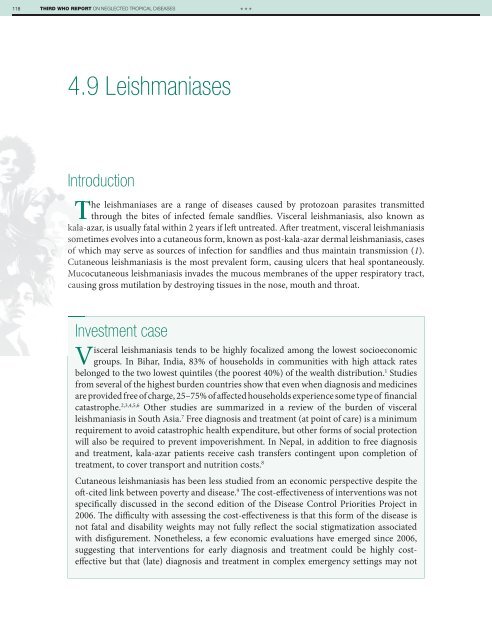1A9bnbK
1A9bnbK
1A9bnbK
You also want an ePaper? Increase the reach of your titles
YUMPU automatically turns print PDFs into web optimized ePapers that Google loves.
118 THIRD WHO REPORT ON NEGLECTED TROPICAL DISEASES<br />
***<br />
4.9 Leishmaniases<br />
Introduction<br />
The leishmaniases are a range of diseases caused by protozoan parasites transmitted<br />
through the bites of infected female sandflies. Visceral leishmaniasis, also known as<br />
kala-azar, is usually fatal within 2 years if left untreated. After treatment, visceral leishmaniasis<br />
sometimes evolves into a cutaneous form, known as post-kala-azar dermal leishmaniasis, cases<br />
of which may serve as sources of infection for sandflies and thus maintain transmission (1).<br />
Cutaneous leishmaniasis is the most prevalent form, causing ulcers that heal spontaneously.<br />
Mucocutaneous leishmaniasis invades the mucous membranes of the upper respiratory tract,<br />
causing gross mutilation by destroying tissues in the nose, mouth and throat.<br />
Investment case<br />
Visceral leishmaniasis tends to be highly focalized among the lowest socioeconomic<br />
groups. In Bihar, India, 83% of households in communities with high attack rates<br />
belonged to the two lowest quintiles (the poorest 40%) of the wealth distribution. 1 Studies<br />
from several of the highest burden countries show that even when diagnosis and medicines<br />
are provided free of charge, 25–75% of affected households experience some type of financial<br />
catastrophe. 2,3,4,5,6 Other studies are summarized in a review of the burden of visceral<br />
leishmaniasis in South Asia. 7 Free diagnosis and treatment (at point of care) is a minimum<br />
requirement to avoid catastrophic health expenditure, but other forms of social protection<br />
will also be required to prevent impoverishment. In Nepal, in addition to free diagnosis<br />
and treatment, kala-azar patients receive cash transfers contingent upon completion of<br />
treatment, to cover transport and nutrition costs. 8<br />
Cutaneous leishmaniasis has been less studied from an economic perspective despite the<br />
oft-cited link between poverty and disease. 9 The cost-effectiveness of interventions was not<br />
specifically discussed in the second edition of the Disease Control Priorities Project in<br />
2006. The difficulty with assessing the cost-effectiveness is that this form of the disease is<br />
not fatal and disability weights may not fully reflect the social stigmatization associated<br />
with disfigurement. Nonetheless, a few economic evaluations have emerged since 2006,<br />
suggesting that interventions for early diagnosis and treatment could be highly costeffective<br />
but that (late) diagnosis and treatment in complex emergency settings may not


